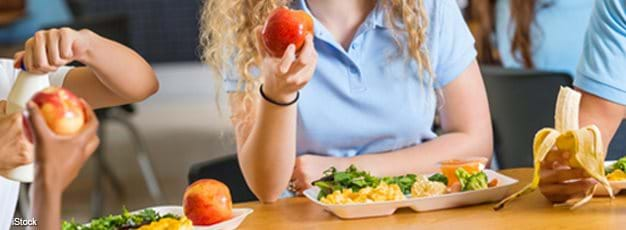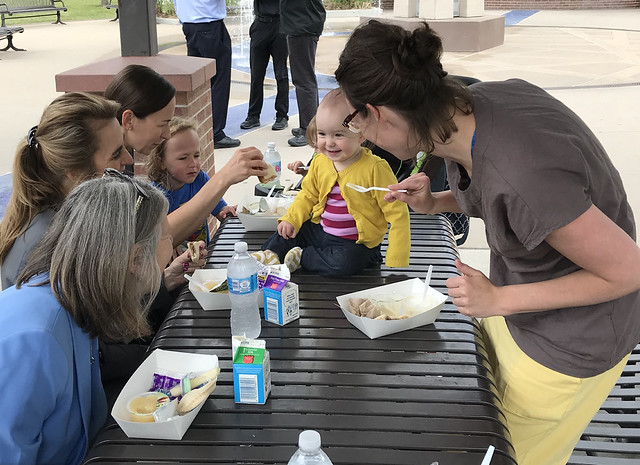Written by: Oana Groza
The U.S. Department of Agriculture’s Food and Nutrition agency created a number of federal nutrition assistance programs over the last several decades to help alleviate food insecurity among individuals and families.
Navigating these different programs (and all the different acronyms) can be intimidating! We created this resource guide to provide a simple, quick overview of these programs without the confusing language. This guide provides a brief snapshot of the program: who it is for and what it does. While not all of these programs may apply to you, it is important to familiarize yourself with the different types of resources out there. It may be useful for a friend or family member. Many are not aware that these programs exist and could use the extra support these programs provide!
It is also important to advocate for these programs to ensure that our legislators continue to fund these programs. Operating nutrition assistance programs ensures a healthy, thriving community.
National School Lunch and School Breakfast Program
The National School Lunch Program (NSLP) is a federal program that operates in public and nonprofit private schools and residential child care institutions. This program provides nutritionally balanced, low-cost or free lunches to millions kids each school day. In 2019, schools served over 4.8 billion lunches to children nationwide. Wow! School meals are important to student health and ensure they have the nutrition they need in order to learn!
Similar to the NSLP, the USDA also operates the School Breakfast Program (SBP) which provides reimbursement to states to operate nonprofit breakfast programs in schools and residential childcare institutions. More children participate in the NSLP than the SBP. In November 2020, the USDA reported that 30 million children participate in the NSLP across 97,000 schools and institutions compared to 15 million in the SBP. However, about 2 in 5 students who have never participated in the SBP say they would if offered in their school. Breakfast is essential to a student’s success. Children who eat breakfast have improved moods and increased alertness throughout the morning.
These programs are both important because they provide access to free or reduced meals in school. Some schools may require an application in order to enroll in the program. If you are interested in applying, reach out to your school’s nutrition department or guidance counselor. Schools and families can access free nutrition information at teamnutrition.usda.gov. To learn more about the USDA pandemic flexibilities, visit fns.usda.gov/coronavirus.

(Image from USDA)
Pandemic EBT (P-EBT)
Pandemic Electronic Benefit Transfer (P-EBT) is part of the U.S. government response to the COVID-19 pandemic. The Families First Coronavirus Response Act of 2020 provides the Secretary of Agriculture authority to approve state agency plans to administer P-EBT.
Through P-EBT, eligible school children receive temporary emergency nutrition benefits loaded on EBT cards that are used to purchase food. Children who would have received free or reduced-price meals under the National School Lunch Act if their schools were not closed or operating with reduced hours or attendance for at least 5 consecutive days are eligible to receive P-EBT benefits. P-EBT also provides benefits to younger children in households participating in the Supplemental Nutrition Assistance Program (SNAP) whose covered child care facility is closed or operating with reduced hours or attendance, or who live in the area of schools that are closed or operating with reduced hours or attendance.
Find the list of states approved to distribute benefits for the 2022-2023 School Year here.
(An example of a P-EBT card)
Summer Food Service Program (SFSP)
During the summer, many students do not have access to the free or reduced meals they received in school. As a result, in order to reduce the number of missed meals when school is not in session, summer meals for kids, or also known as the Summer Food Service Program (SFSP) was created. The SFSP is a federally-funded, state-administered program. Children 18 years and younger may receive free meals and snacks through SFSP. In 2019, the SFSP provided more than 141 million nutritious meals and snacks to children during the summer when school was not in session.
Typically, summer meal sites are operated by schools, public organizations (e.g., parks, libraries), nonprofits (e.g., YMCA, Big Brother), or housing communities. At most sites, children receive one or two meals each day. To find a summer meal site near you, go to fns.usda.gov/meals4kids. Please be sure to confirm hours and days of operation before visiting a site.

(Image from the USDA)
Supplemental Nutrition Assistance Program (SNAP)
The Supplemental Nutrition Assistance Program (SNAP) was created to provide nutrition benefits to supplement the food budget of needy families so they can purchase healthy food and move towards self-sufficiency. This program was previously referred to as “Food Stamps” but was officially renamed to SNAP in 2008. Some states may still refer to it as Food Stamps, while others have created their own name. For example, California refers to the program as CalFresh.
The application process takes anywhere from 7-30 days to process. If the caseworker determines that it is an emergency situation, some applicants may be eligible for “expedited” or “emergency” SNAP. There are specific eligibility requirements for this type of application. Some states even take applications over the phone! Once approved, you will receive an EBT card (functions like a debit card) and your benefits will be loaded onto the card on a monthly basis. In some states, families that receive SNAP will also receive their child’s P-EBT benefits on the same card.
Additionally, you can now use your SNAP benefits to place online orders for delivery Please note that retailers vary on a state-by-state basis and SNAP benefits cannot be used to pay delivery fees. Be sure to confirm an online store delivers to your home address. Find the list of approved retailers in your state on this website.
Generally, students ages 18 through 49 who are enrolled in college at least half time are not eligible for SNAP unless they meet certain specific exemptions. However, the new, temporary change to student eligibility means that certain students who were not eligible for SNAP before may now be eligible! For additional information about SNAP in your state, to file an application for SNAP benefits, or to get information about your SNAP case, contact your local SNAP office.
Many Farmers’ Markets, CSA, and farm stands also take SNAP benefits. Some states encourage recipients to support local businesses and farmers through programs such as “Double Up Bucks“. Double Up helps you bring home more healthy food by matching your SNAP benefits. Essentially, for every SNAP dollar you spend at a participating location, you will receive a one dollar match to spend on fresh fruits and veggies.
Find program information in your state here!
(Example of a state’s EBT card (California))
Food Distribution Program on Indian Reservations (FDPIR)
The Food Distribution Program on Indian Reservations (FDPIR) provides USDA Foods to income-eligible households living on Indian reservations, and to American Indian households residing in approved areas near reservations or in Oklahoma. FDPIR offers a wide variety of fresh fruits and vegetables, frozen meats, whole grains, and traditional foods. USDA purchases and ships USDA Foods, selected from a list of available foods, to the ITOs and state agencies. These administering agencies store and distribute the foods, determine applicant eligibility, and provide nutrition education to recipients. Please note that you cannot participate in this program if you currently receive SNAP benefits. Learn more about FDPIR by visiting the USDA’s website!

(Image from USDA)
Special Supplemental Nutrition Program for Women, Infants, and Children (WIC)
The Special Supplemental Nutrition Program for Women, Infants, and Children (WIC), aims to safeguard the health of low-income women, infants, and children up to age 5 who are at nutritional risk by providing nutritious foods to supplement diets, information on healthy eating, and referrals to health care.
Pregnant, postpartum, and breastfeeding women, infants, and children (under 5) who meet the eligibility requirements (household income, nutrition risk, household composition) are eligible for benefits.
The foods provided through the WIC program are designed to supplement participants’ diets with specific nutrients. WIC-authorized foods include (but are not limited to): infant cereal and baby foods, iron-fortified adult cereal, infant formula, fruits and veggies, eggs, milk, cheese, and yogurt. WIC participants also have access to resources such as health screenings, nutrition & breastfeeding counseling, and immunization.
If you want to find a WIC clinic near you, go to signupwic.com!

(Image from Texas WIC)
Child & Adult Care Food Program (CACFP)
The Child and Adult Care Food Program (CACFP) is a federal program that provides reimbursements for nutritious meals and snacks to eligible children and adults who are enrolled for care at participating sites. Each day, 3.3 million children receive nutritious meals and snacks through this program.
Types of CACFP-eligible sites:
- Child care centers
- Day care homes
- After school care programs
- Emergency shelters
- Adult day care centers
Learn more about the program here!

(Image from FRAC)
